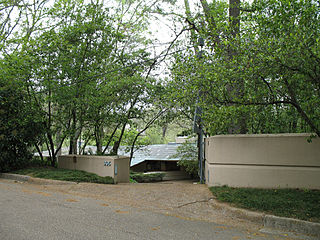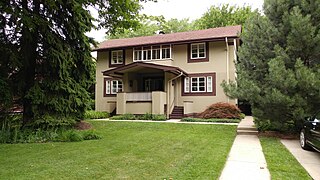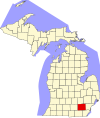
The Thomas E. Keys Residence is a house in Rochester, Minnesota designed by Frank Lloyd Wright and built with earth berms in 1950. The design is based on a previous Wright design for a cooperative in Detroit, Michigan, which never materialized due to the onset of World War II. The house is an example of Wright's Usonian genre of architecture, a style he envisioned to meet the needs of middle-class families desiring a more refined architecture for their homes. The home had three bedrooms and one bathroom, and is constructed with concrete block. It is based on a square module of four feet on a side. Architect John H. "Jack" Howe converted the home's carport into a guest bedroom and bath in 1970.

Designed by America's famous architect Frank Lloyd Wright, the Schaberg House was commissioned in 1950 by Donald and Mary Lou Schaberg. The house is an example of Wright's now-famous Usonian style. The house is located in Okemos, Ingham County, central-southern Michigan.

The Edward C. Waller Apartments are located from 2840 to 2858 W. Walnut Street in Chicago, Illinois. They were designed by Frank Lloyd Wright and built in 1895 and named after Edward C. Waller, a prominent Chicago developer after the 1871 fire. Waller and Wright collaborated on the Waller apartments and the Francisco Terrace apartments to execute Waller's pioneering idea of subsidizing lower income housing. Each apartment was designed with a parlor, chamber (bedroom), dining room,kitchen, bathroom, and closets.

The Bernard Schwartz House, also known as Still Bend, is a 3,000 sq foot Frank Lloyd Wright-designed house in Two Rivers, Wisconsin. It is considered to be Wright's Life magazine "Dream House," and is a rare example of a two-story Usonian house. Wright originally developed the design for the house for Life in 1938. The Schwartz House is one of the few Wright homes that allow guests to spend the night. This property is believed to have the oldest, continuously operating in-floor heating system in the country.

Edward Serlin House was completed in 1949, and is the second of three designs by Frank Lloyd Wright for Usonia, planned as a cooperative community starting in the late 1940s. This is now known as the Usonia Historic District and is located in Pleasantville, New York. The community was listed on the National Register of Historic Places in 2012.

The Ben Rebhuhn House was built in Great Neck Estates, New York in 1937. This home is the only home on Long Island designed by Frank Lloyd Wright at the request of Benjamin and Anne Rebhuhn, publishers of progressive content. This house is similar to the Ernest Vosburgh House in Grand Beach, Michigan, except that this house is in the Usonian style while the Vosburgh residence, built 21 years earlier, was in the Prairie style. The house follows a cruciform plan. The house features a two-story living room and is built from tidewater red cypress board and batten inside and out, with brick and red roof tile. Notable owners of the house have included Texas oil heiress Diane Reid.

The Carlton D. Wall House, also known as Snowflake, is a Frank Lloyd Wright designed home in Plymouth Township, Michigan. It is one of Wright's more elaborate Usonian homes. In 1941, recently married Mr. and Mrs. Carlton David Wall, who were Wright's youngest clients, approached Wright to design a house for them after Carlton Wall studied Wright's architecture in college.

The Frederick C. Bogk House is Frank Lloyd Wright's only single-family residential project in Milwaukee, Wisconsin. Bogk was an alderman and secretary-treasurer of the Ricketson Paint Works. This house embodies Wright's prairie style elements into a solid-looking structure that appears impregnable.

The John Gillin Residence is a large single-story Usonian house, designed by Frank Lloyd Wright in 1950 and built in Dallas, Texas, in 1958. The Gillin House is Wright's only residential project in Dallas. Gillin, a successful oilman, geophysicist and electronics "gadgeteer", commissioned Wright to design a work of art that would also be suitable for living and entertaining. A self-made man, Wright respected him and allowed him to design many details including all door hardware, the stainless steel kitchenettes and even the diving board support.

Fountainhead is a historic house located at 306 Glenway Drive in Jackson, Mississippi.

The Warren Hickox House, also known as the Hickox/Brown house, is a 1900 Frank Lloyd Wright house in the Prairie School style in Kankakee, Illinois, United States. The house design is similar to two articles Wright published in the Ladies' Home Journal.

Duey and Julia Wright House is a Frank Lloyd Wright designed Usonian home that was constructed on a bluff above the Wisconsin River in Wausau, Wisconsin in 1958. Viewed from the sky, the house resembles a musical note. The client owned a Wausau music store. The home also has perforated boards on the clerestories "represent the rhythm of Beethoven's Fifth Symphony Allegro con brio first theme." A photograph showing the perforated panels is in the web page on the National Register application.

The 1905 Mary W. Adams House, is a Frank Lloyd Wright designed Prairie School home that was constructed in Highland Park, Illinois. The Adams House is a two-story home with three bedrooms and two bathrooms with a light stucco exterior and wooden trim that emphasizes the horizontal.

The Dorothy H. Turkel House is a private residence located at 2760 West 7 Mile Road in north-central Detroit, Michigan, within the Palmer Woods neighborhood. It was designed by Frank Lloyd Wright and completed in 1956.
The Keland House, located in Racine, Wisconsin in the United States, was designed by Frank Lloyd Wright in 1954, almost 50 years after he designed the Thomas P. Hardy House in Racine. It is currently known as the Boyd Home. The residence is on a bluff, cantilevered over the Root River and overlooking Colonial Park. The only furniture that Wright designed for the home were built-ins: ledges, bookcases, cabinets and sofas. The first time Wright visited the home after it was completed, he proceeded to rearrange the furniture. It has multiple wings, with an inner atrium. The primary construction material is brick, with a copper roof.

The Walter Gerts House in River Forest, Illinois, the United States, was originally designed in 1905 by Charles E. White, who studied with Frank Lloyd Wright at his Oak Park studio. White went on to pursue a successful career as both an architect and writer about related matters, and designed several important buildings in Oak Park including the massive Art Deco post office in 1933. The house shows influences both from White's East Coast beginnings in its colonial symmetry and his training with Wright in the Prairie School of architecture.

The Patrick and Margaret Kinney House was designed by architect Frank Lloyd Wright and it was built in 1951. The home is located in Lancaster, Wisconsin. The house was added to the State Register of Historic Places in 2007 and to the National Register of Historic Places the following year.

The Sidney Bazett House, also known as the Bazett-Frank House, is a Usonian-style home on 101 Reservoir Road in Hillsborough, California, United States, designed in 1939 by American architect Frank Lloyd Wright. Sidney Bazett wrote to the architect that, "With even our meager artistic knowledge,... it was apparent that it would be a shame to have anyone other than Frank Lloyd Wright design our home." The house is on a hexagonal module with red concrete floors, brick massing, underfloor heating, wooden built-in benches and bookcases, and a flat roof with deep overhangs for natural cooling. The house is similarly designed to the Hanna House, another Wright design with a hexagonal module, also in California. However, it is "a smaller, less expansive version of the... Hanna House on the Stanford Campus; the clients were friends of the Hanna family."
The Lawrence Memorial Library was designed in Springfield, Illinois in 1905 by American architect Frank Lloyd Wright for client Susan Lawrence Dana. Wright had designed Susan Lawrence Dana's home, also in Springfield, in 1902-04.

The George Blossom House in Chicago was designed by architect Frank Lloyd Wright in 1892, while Wright was still working in the firm of Adler and Sullivan. As Wright was working as a draftsman for Adler and Sullivan, he was forbidden from taking outside commissions. He later referred to these designs as his "bootleg houses".























